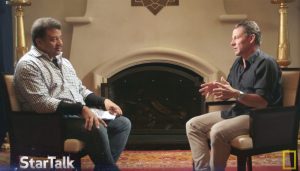Sunday night, 1Oct17, the National Geographic Channel broadcast the fourth season premier of Neil deGrasse Tyson’s Star Talk from the Hayden Planetarium in New York’s Museum of Natural History. The show included Neil’s interview with Lance Armstrong the bicyclist who won the Tour de France seven consecutive times only to have his titles taken away from him because of his use of performance enhancing drugs. The choice of Armstrong as the interview choice for the first show of the season was an unusual one but the show was both interesting and informative. The image below shows Neil with Lance Armstrong.

Now the interview with Armstrong was taped but Neil had two guests with him live at the Hayden Planetarium. One of the guests was Scott Adsit, a comedian who has appeared on the show several times now. Neil always has a comic as one of his guests to interject a few laughs into the more serious discussion. To provide the background on the science of bicycling the other guest was Max Ginskin, the author of the book Cycling Science.
The first half of the show dealt with the history and science of cycling discussing topics such as the history of the Tour de France along with the importance of aerodynamics in cycling. There was also a segment on the way the performance of a cyclist is measured using the ratio of the power his muscles can produce to his body mass in kilos. The image below shows one of the show’s regulars undergoing the sort of testing professional athletes use to measure their performance.

The second half of the show dealt with the more controversial subject of Lance Armstrong’s admitted use of performance enhancing drugs or PDEs. For this segment Professor Arthur Caplan, a bioethicist from New York University joined Neil and his live discussion.
As I said, Armstrong has now admitted to using PDEs but maintains not only that everybody was using them but also that the drugs had become so powerful and pervasive that it was impossible to compete without them. Without absolving Armstrong, Professor Caplan agreed the governing body in cycling shared the responsibility for failing to address the problem with adequate testing and appropriate penalties.
To challenge Professor Caplan, Neil brought up the argument that, if everybody is using PDEs then the playing field is still level, the competition still fair so why not let the athletes use PDEs if they want. Professor Caplan replied with three points that I’d like to repeat.
- If everyone uses PDEs the competition is only longer between athletes but between drug companies negating the whole point of athletics.
- For those who love their sports part of the fun is comparing past performances to modern ones. Just this past season in Major League Baseball’s Juan Carlo Stanton hit 59 home runs leaving him just one short of a level of success that only two players in history have ever fairly attained! Like cycling the MLB has to confront its having turned a blind eye to drug use in the past.
- (And this is the most important point). These drugs are not safe. Even the use of cortisone for pain relief should be done cautiously. Steroids and other even more powerful drugs have numerous long term health risks. And even if you think adults should be allowed to take such risks if they choose to, what about the 16, 17 hey even 14 year old who dreams of a career in sports? For a teenager to use PDEs will certainly lead to severe health problems when they are in their 40s or 50s.
That’s the value of science, that it gives you the facts so you can make an ethical, reasonable judgment. And that’s the value of Star Talk with Neil deGrasse Tyson. If you’d like to learn more about the show ‘Star Talk’, find out where you can watch it, click on the link below to be taken to the Star Talk website.
http://channel.nationalgeographic.com/startalk/
